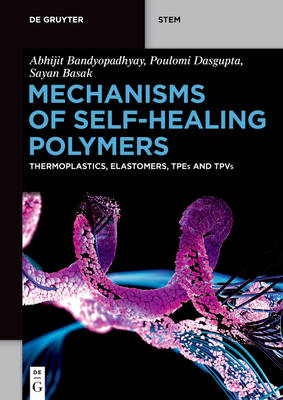
- Afhalen na 1 uur in een winkel met voorraad
- Gratis thuislevering in België vanaf € 30
- Ruim aanbod met 7 miljoen producten
- Afhalen na 1 uur in een winkel met voorraad
- Gratis thuislevering in België vanaf € 30
- Ruim aanbod met 7 miljoen producten
Zoeken
Mechanisms of Self-Healing Polymers
Thermoplastics, Elastomers, Tpes and Tpvs
Abhijit Bandyopadhyay, Poulomi Dasgupta, Sayan Basak
€ 140,45
+ 280 punten
Omschrijving
Self-healing synthetic materials have the ability to repair damage on their own, restoring functionality and significantly extending the lifespan, energy efficiency, safety, and environmental impact of synthetic materials. These materials can mimic self-repair mechanisms in biological materials and regain their original functionalities, ensuring prolonged durability. Methods for repairing mechanically damaged polymeric materials include using photo-activated healing agents, reversible covalent bonds, cycloaddition reactions, metal-ligand complexes, and dynamic non-covalent bonding. The initial chapter of the book lays the introduction by offering a fundamental overview of self-healing materials. It encompasses a spectrum of smart materials, from self-healing polymers to self-healing ceramics. The next section introduces the mechanisms that endow these materials with their remarkable properties. It explores various self-healing strategies, underlying chemistries, and stimulus responsiveness crucial for achieving these self-repairing abilities. The book then focuses on the processing aspect of these materials, detailing diverse fabrication methods used for developing these intelligent polymers, both in laboratory settings and at an industrial scale. The next section centers on self-healing elastomers, encompassing thermoplastic elastomers and thermoplastic vulcanizates. It not only provides an overview but delves into the synthesis, structure-property relationships, and applications of these elastomers molded as self-healing materials. The book concludes with potential applications of these smart materials. It is structured around specific properties such as mechanical or rheological characteristics, showcasing how these traits inspire the practical application of self-healing elastomers.
Specificaties
Betrokkenen
- Auteur(s):
- Uitgeverij:
Inhoud
- Aantal bladzijden:
- 219
- Taal:
- Engels
- Reeks:
Eigenschappen
- Productcode (EAN):
- 9783111583099
- Verschijningsdatum:
- 1/12/2025
- Uitvoering:
- Paperback
- Formaat:
- Trade paperback (VS)
- Afmetingen:
- 170 mm x 244 mm
- Gewicht:
- 331 g

Alleen bij Standaard Boekhandel
+ 280 punten op je klantenkaart van Standaard Boekhandel
Beoordelingen
We publiceren alleen reviews die voldoen aan de voorwaarden voor reviews. Bekijk onze voorwaarden voor reviews.








